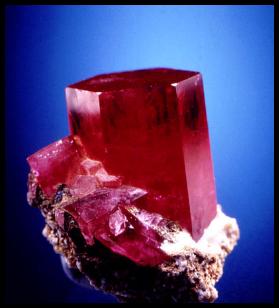|
It is difficult to determine which of the fabulous gem materials found on earth is the rarest. Certainly, red beryl from the Wah Wah Mountains of Utah would be near the top of any rare gemstone list. In fact, red beryl ( a beryllium silicate colored by Mn3+) is so rare, most people don't even know that it exists. Gem beryl occurs in a varitey of colors; green (emerald), light blue (aquamarine), yellow (heliodor), pink, (morganite), and very rarely, a deep red with no accepted common name. Although red beryl was first reported almost 100 years ago, from a deposit in the Thomas Range of Utah, it wasn't until the late 1950's that Lamar Hodges discovered the deposit now known as the Ruby Violet Mine. The red beryl crystals occur in fissures in a host rhyolite. The gemmy crystals have been found in an area measuring only about 900 x 1900 meters. In 1976 the Harris family of Delta Utah purchased mining rights to the property and produced a small but steady supply of gem quality red beryl. In 1994 Kennecott Exploration Co. (KEC) entered into an option agreement with the mine owners to purchase the mine and surrounding claims. KEC performed an extensive exploration program of core drilling and under-ground bulk sampling to confirm the extent and richness of the red beryl deposit. That study showed the deposit would yield approximately 1.25 carats of red beryl per ton of ore. Assuming a faceting yield of 10%, one ton of ore would yield 0.125 carats of finished gemstones. Other companies later evaluated the possibility of large scale mining and marketing of red beryl from the Ruby Violet Mine, but that has not yet happened. The Harris group once again controls the mine, and plans to continue their small scale operation. The red beryl that is produced is sold as both mineral specimens and faceted gemstones. The average weight of cut stones is about 0.20 carats. Only 10% of the cut gemstones exceed 1 carat in weight. To date the largest faceted red beryl weighs 4.5 carats. A number of articles have been written about the history and geology of the Ruby Violet red beryl deposit. If you would like further information see "Red Beryl from Utah: A Review and Update," by James E. Shigley, Timothy J. Thompson, and Jeffrey D. Keith; Gems & Gemology, 2003, V39, pgs. 302-313.
|
|

